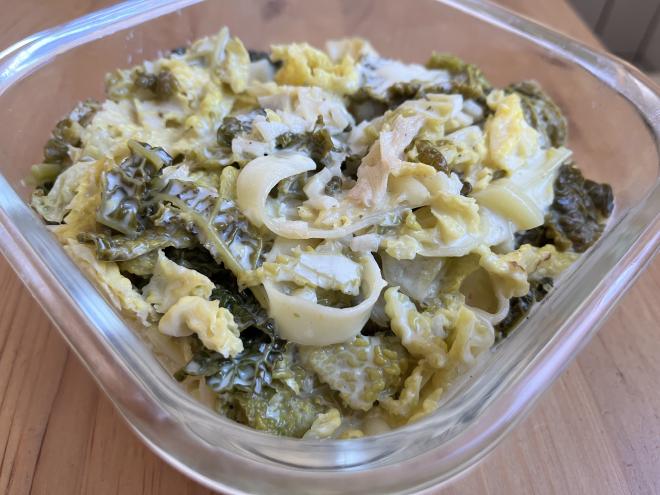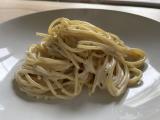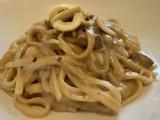Pasta with Savoy Cabbage-Lemon Cream Sauce
Table of Contents
Jump to Recipe
Jump to Carbon Footprint
Savoy cabbage is not normally one of my favorite vegetables, but I really like it in this sauce. The slight bitterness of the cabbage works well with the acidity of the lemon. Overall, the sauce is rather light and not at all reminiscent of cabbage.
The recipe is very simple: you only need a few ingredients, and you can have a meal on the table in less than twenty minutes. So if you’re in a hurry, it’s perfect.
When buying lemons, make sure they are organic: we want to use the zest here too, so it is best if they have not been treated with herbicides or pesticides. It may be tempting to skip the zest and just use lemon juice instead, but I really recommend using a lemon: It’s the zest that gives you that great fresh lemon flavor.

Recipe #
Pasta with savoy cabbage and lemon cream sauce
15 minutes
2 portions
Ingredients #
- 200 g savoy cabbage
- 1 small onion
- 1 clove garlic
- 1 tablespoon oil
- 1 small organic lemon
- 75 ml cream
- 1 pinch of salt
- 1 pinch of pepper
- 200 g pasta, e.g. linguine
- 25 g Parmesan cheese
Directions #
- Separate the savoy cabbage into individual leaves, wash, remove the hard stalk, and cut into pieces of about 1 cm.
- Finely dice the onion and garlic, and fry in a large pan with a little oil. When the onion is soft, add the cabbage and sauté.
- At the same time, cook the pasta in salted water.
- Finely grate the lemon zest and add to the cabbage. Add the cream, season with salt and pepper, and continue to cook while the pasta is cooking.
- Squeeze the lemon and add the juice to the sauce. If there is not enough liquid in the sauce, add some of the water from the pasta: the starch from the pasta will dissolve in the water and give the sauce a good consistency.
- When the pasta is ready, drain and serve with the cabbage cream sauce and grated Parmesan cheese.
Carbon Footprint #
In total, two portions of pasta with savoy cabbage and lemon cream sauce have an estimated carbon footprint of 943 g.
This ranks it number 10 out of 57 recipes published on the blog so far in terms of estimated carbon footprint.
This means that it belongs to the quarter of recipes that have the lowest climate impact (i.e. top 25%). 🥰Looking at the ingredients, cream and Parmesan stand out: In both cases, this is due to the rather CO2-intensive dairy industry, mainly because several liters of milk are needed to produce a corresponding amount of cream or cheese. Savoy cabbage, on the other hand, has a very favorable carbon footprint: it accounts for almost a third of the weight of the ingredients, but only just over 10% of the carbon footprint.
| ingredient | carbon footprint per kg | carbon footprint (in g) for 2 servings | % of ingredients | % of CO2 emissions |
|---|---|---|---|---|
| Savoy cabbage | 0.5 | 100.0 | 31% | 11% |
| Onion | 0.2 | 10.0 | 8% | 1% |
| Garlic | 0.5 | 1.4 | 0% | 0% |
| Oil | 3.2 | 32.0 | 2% | 3% |
| Lemon (organic) | 1.9 | 133.0 | 11% | 14% |
| Cream | 4.2 | 315.0 | 12% | 33% |
| Salt | 1.4 | 1.4 | 0% | 0% |
| Pepper | 1.4 | 1.4 | 0% | 0% |
| Pasta | 0.7 | 140.0 | 31% | 15% |
| Parmesan | 6.3 | 157.5 | 4% | 17% |
| Cook sauce (10min) | 13.4 | 1% | ||
| Cook pasta (10min) | 38.3 | 4% |


